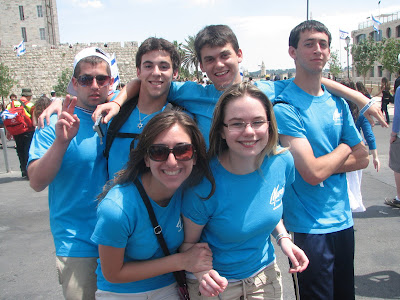Majdanek -- May 1, 2008
We drove three hours from Warsaw to the death camp Majdanek. With us we had Sophie Steinbuch who was taken, along with her mother and sister to Majdanek as a ten year old girl. Walking into the camp, we were dumbstruck by the proximity of the camp to the town where it was located. The camp was literally built adjacent to and a stone’s throw away from the places where Poles lived and worked. The crematorium was no more than a football field’s distance away from the town! Unlike Treblinka, which was hidden deep in the forest, Majdanek was built to be seen.

You walk into the camp by passing beneath an enormous stone sculpture. The experience is one of being sucked into the camp. We walked down a sloped concrete path where once at the bottom we felt like we were trapped in the bottom of a pit. From the bottom of the trench, the steep stone steps leading out looked like an impassable stone wall. The sides are comprised of enormous stone slabs, through which we could see one sliver of the adjacent town. Only a sliver of sky was visible from the bottom of the pit looking up at the sculpture we would pass under before entering the camp. It was in this setting that Sophie told us her own story of being a prisoner at the camp.

When she arrived with her mother and sister, her mother was immediately separated from her mother and sister. She told us about entering the showers and how hot and crowded and horrible it was. She recalled having her hair shorn off and how she cried and fought in protest. She also described how she felt lucky that on more than one occasion, being a young girl of ten or eleven, there were people who felt sorry for her and took care of her. She couldn’t adequately find the words to describe her experience and resulted to such things as “horrible” and “hell” but what she didn’t say became evident to us as we toured the camp itself.a

Words cannot adequately describe the chills I got when I walked into the shower barrack. We entered another barrack which was used by the Germans as a storage facility. Storage for what? When the Jews left their towns to be transported to the concentration camps, they wore their best traveling clothes and packed their most valuable possessions. These are the items that were “stored” by the Nazis. Gold, silver, and copper coins. Candlesticks, artwork, money, clothing. The room was now used to house 5000 pairs of shoes. The smell of the leather was overwhelming. There were so many shoes that my brain could not initially perceive of them as shoes. They appeared at first as a charcoal drawing on the wall. When I slowly walked closer I could see that they were individual shoes – high heel pumps, spectators, saddle shoes – evidence of the best shoes that belonged to the former owners.
We saw the barracks which were actually prefabricated horse stables designed to house, at most, 50 horses. In each barrack, 800 Jews were housed. The camp is enormous. Larger than you could ever imagine. We entered the crematorium and I was sickened by the first thing I saw which was the dissection table. After the Jews were murdered, their body was placed on a dissection table where it was searched to find any valuables that were hidden within the body. Our guide, Sheryl, told us a story of a woman who possessed a diamond. Her mother told her to swallow the diamond. And that is what she did. Again and again.
Our final stop at Majdanek was the crematorium. How sick were the nazis? Within the crematorium was a bathroom with a large bath. The heat from the ovens burning the bodies of the Jews was so intense that it was capable of heating water for the bath of the SS officer who worked in the crematorium. We said Kaddish for the pour souls who died at the camp and sang Hatikva together before leaving. Before we left the camp, we lit memorial candles at the memorial for those slaughtered at Majdanek. The memorial is the resting place for the seven tons of human ash that belonged to the departed.

Natalie Wolf






 Finally, everyone rose to sing Hatikva and as we were singing I realized that the last time we had sang The Hope, the national anthem for the State of Israel, we were standing in Block 11 in Auschwitz. It's amazing how far we've come since then.
Finally, everyone rose to sing Hatikva and as we were singing I realized that the last time we had sang The Hope, the national anthem for the State of Israel, we were standing in Block 11 in Auschwitz. It's amazing how far we've come since then.















